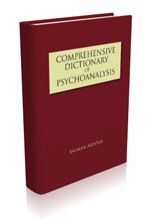Comprehensive Dictionary of Psychoanalysis
I believe this book will serve as an invaluable resource for all students of psychodynamic theory as well as their teachers-and I would venture to say that this magisterial text is destined to become a classic.
I have been eagerly awaiting Dr Salman Akhtar’s Comprehensive Dictionary of Psychoanalysis since I learned about this project. Dr Akhtar’s 300-plus publications encompass diverse and eclectic topics: immigration, relationships with animals, severe personality disorders, love, forgiveness, sociopathy, violence, terrorism, boundaries, narcissism, cross-cultural psychoanalysis, poetry, materialism and physical possessions, movies, siblings, twins-and the list goes on.
The Comprehensive Dictionary of Psychoanalysis consists of 1853 entries. There are 2181 primary sources in the bibliography, which fall under 1096 separate author entries. To accurately describe the contents of this work, I will divide its entries into 3 categories. The first is a clear, concise, formidably referenced, and contemporary synopsis of fundamental psychodynamic concepts: attachment theory, ego ideal, internalization, internal objects, object, object constancy, and object representation, to name a few.
Another category consists of brief, erudite review essays on important clinical and theoretical topics, such as Falling Asleep During the Session, Emptiness, Faith, Femininity, Gifts, Homosexuality, and Telephone Analysis. These feature Dr Akhtar’s unique blend of faithful synopsis of the ideas of others with his creative and elucidative thinking.
The third category contains what Dr Akhtar believes to be the most original and important contributions to psychoanalysis over the past few decades. I particularly enjoyed are fascist state of mind (Christopher Bollas’ term for the mental characteristics in individuals who have surrendered their judgment and critical thinking to extremist political or religious ideologies); Nobel prize complex (Helen Tartakoff’s description of a personality syndrome in certain narcissistic persons who are blessed with unusual talents and attain unusual accomplishments); geopolitical identity disorder (Ira Brenner’s metaphor for the incessantly destructive nature of the Arab-Israeli Conflict); and we-self (Alan Roland’s description of psychic structure in Asian cultures that emphasizes connectedness to groups or communities).
Dr Akhtar appears to gravitate to writers who take psychoanalysis outside the consulting room and beyond bourgeois, Western culture. He is expanding the canon of psychoanalytic knowledge to include the contributions of contemporary authors. The great significance of this is that Akhtar has endorsed the creative work of a new generation of psychoanalytic thinkers. I believe this book will serve as an invaluable resource for all students of psychodynamic theory as well as their teachers-and I would venture to say that this magisterial text is destined to become a classic.

